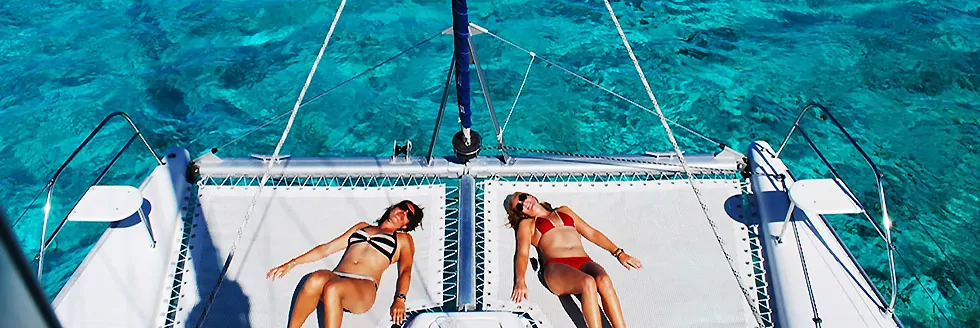Anchorages, Moorings & Marine Protected Areas
Anchoring
Most official charts (from NAMRIA, U.S. Geological Survey and the U.K. Hydrographic Department) will show anchorages – places where it has long been the practice to anchor large vessels. However, as these charts were largely created in the years before the rise in the passion for sailing cruises for pleasure, they are not very useful to the cruising yacht captain.
At this time there is no comprehensive resource for anchorages for cruising yachts in the Philippines. Having said that, users of the Navionics computer or tablet Chart App will find many anchorages marked, as contributions by cruisers, that have been proven to be useful at times for route planning.
As a general rule, if you find a bay where there is a fishing community, with local banka boats laying at anchor, then it is fairly safe to assume that you can also drop anchor in the vicinity.
Also, because the navigation charts of the Philippines are frequently out of date and sometimes lack accuracy, it is always a good idea to plan to arrive at a new anchorage while the sun is high in the sky (at least before 4.00pm), so that you have best view of what lies beneath the surface.
Finally, every town and village that has a coastline is required under Philippine law to designate certain areas as Marine Protected Areas. Each individual Marine Protected Area may have restrictions on anchoring. Every community will have a group of designated members who form the “Bantay Dagat” or, “protectors (bantay) of the sea” (dagat). Working closely with Philippine Coast Guard and local government, the bantay dagat are tasked with enforcing the local regulations covering Marine Protected Areas.
Anchoring Best Practices
- where possible, contact municipalities in advance in the area you intend to anchor to determine Marine Protected Areas and no-anchoring areas
- if no contact in advance, hail a passing fisherman and ask if anchoring is OK
- plan to arrive at a new anchorage before 4.00pm so that you can see where your anchor will drop
- always choose to drop your anchor on an area of sand, large enough so that your chain/warp does not contact the surrounding coral
- if told to move your yacht by bantay dagat members then do so without complaint
- if asked to pay a small anchoring fee (typically US$2-$10) by someone wearing a bantay dagat or barangay/municipal shirt then pay the fee, record it in your log but do not expect an official receipt
- buy some fish from a passing fishermen where you anchor as a sign of friendship and goodwill
Moorings
Some beach resorts provide moorings for visiting boats. They do this for three main reasons: to encourage people to come ashore and sample their food and hospitality; to moor the resort service boats; and, to protect coral reefs that may provide scuba diving locations or other community income opportunities. If you see a mooring off a beach resort then hail someone in the vicinity and ask if you may pick up the mooring.
Marine protected areas are not found on any published chart. Under Philippine law each barangay (village) and municipality must designate areas as marine protected areas. These protected areas are sanctuaries for marine life and designed to increase the livelihood potential of the adjacent areas by preventing damaging fishing practices. It is forbidden to anchor in an area designated a marine protected area, unless given specific permission to do so.
Many (but not all) marine protected areas are marked by small buoys with flags attached (usually orange or red flags but not always). Frequently, marine protected areas are patrolled by people from the local community who are members of the “bantay dagat” (literally: protectors of the sea) and some of them are known to be less than welcoming to a yacht that drops anchor in a marine protected area. Best practice is to contact the municipality in advance in the area where you plan to drop anchor or hail a fisherman and ask if it is OK.
A small number of marine protected areas have moorings that a visiting yacht may pick up, but this is rare and usually only occurs around island communities where tourism is a recognized source of community income, e.g. in the marine protected area to the North of San Pedro Beach, Romblon Island, there is a (black) mooring that anyone can pick-up. In such cases, you can expect to pay a small fee for picking up a mooring in a marine protected area and, in some cases, if you and your crew choose to swim then there may also be a small fee per person to be paid, e.g. at the Tablas “Blue Hole” the fee is Php100 (about US$2.50) per person entering the water.
If there is a fee for swimming or diving then you will usually find that a guide can be engaged for the purpose of showing you the beauty of the marine protected area and pointing out any unique marine life to be found there.
There are at least two place where the fees are somewhat higher because the areas being protected are more challenging to protect: Tubbataha Reef, in the Sulu Sea; and, Apo Reef in the Mindoro Strait. You are not allowed to anchor at Tubbataha Reef nor at Apo Reef, you must pick up a mooring.
Mooring Fees At Tubbataha Reef
The current mooring fees for Tubbataha Reef are: a mooring fee of Php3,000 (about US$65) for a boat mooring at Tubbataha Reef; and, with an additional visitor fee of Php3,000 (about US$65) for each person entering the water.
Mooring Fees At Apo Reef
The current mooring fees for Apo Reef (Mindoro Strait) are: a mooring fee of Php300-600 (about US$6.50-$13.00) for the boat mooring at Apo Reef, depending on the size of the boat; and, with an additional visitor fee of Php540-2040 (about US$12-$45), depending on whether you just visit or engage in scuba diving.
No-go Sailing Areas
Whilst the Philippines is generally populated by some of the friendliest and welcoming people on the planet, the waters West of Mindanao – West from Dapitan on the North coast and West from Sarangani the South coast – are considered no-go sailing areas. There have been a few incidents overs the years where pleasure yachts at anchor have been boarded, valuable items stolen and or the crew kidnapped.
need more specific information? contact Philippine Yacht Charter with questions
Copyright © 2009-2024 Philippine Yacht Charter; All Rights Reserved


